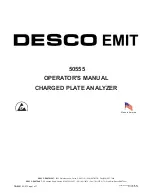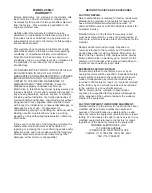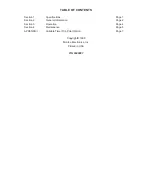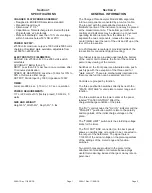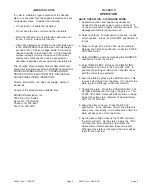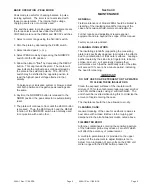
Section 1
SPECIFICATIONS
CHARGED PLATE/PROBE ASSEMBLY:
• Designed to EOS/ESD Association standard
• Standard tripod mount
• Dimensions: 6" X 6"
• Capacitance: Total discharge test circuit with plate
20 picofarads, ±2 picofarads
• Plate self-discharge: Less than 10% of set voltage
within 5 minutes below 50% RH at 25°C
POWER SUPPLY:
±7500 volts maximum output; ±1000 volts/±5000 volts
charging of isolated plate available, adjustable from
<±1000 to >±5000 volts
ELECTROSTATIC FIELDMETER:
RANGE: 0 to ±7500 volts; 0 to ±2000 volts-switch
selectable
ACCURACY: Better than 2%
DRIFT: Less than 0.4% per hour non-cumulative after
10 minutes stabilization
SPEED OF RESPONSE: Less than 100ms for 10% to
90% of full scale either range
OUTPUT: Divide input by 1000, impedance 100W
TIMER:
Full scale 999.9 sec. (>16 min.), 0.1 sec. resolution
POWER REQUIREMENTS:
117 or 220 volts ±10% (factory preset), 50/60 Hz, 5
watts
SIZE AND WEIGHT:
Height 6¾", Width 6¾", Depth 9½"; 5 lbs
Section 2
GENERAL INFORMATION
The Charged Plate Analyzer Model 268A separates
into two components connected by a ten-foot cable.
The top part with the plate attached contains the
fieldmeter portion of the instrument and may be placed
at the measurement site. The bottom part with the
controls and indicators may be placed in a convenient
operating location remote from the detector. To
separate the two components, release the two over-
center latches near the rear of the unit and lift up at the
rear of the top section.
A ¼-20-threaded receptacle is provided inside of the
top section for convenient tripod mounting.
Two foldout legs are provided underneath the bottom
of the control unit to elevate the front of the cabinet to
permit easy viewing of the meters.
Switches on the front panel are alternate action push-
push type with the exception of the three used for
"plate control". These are mechanically interlocked so
that only one function can be selected at a time.
Controls are grouped by function.
The three pushbutton switches directly beneath the
"PLATE VOLTAGE" meter relate to meter range and
function.
The three switches at the lower center of the panel
labeled "PLATE CONTROL" affect the
charge/discharge condition of the plate.
The "HV" control knobs, the "HV ON" indicator and the
"POLARITY" pushbutton switch relate to the polarity
and magnitude of the initial charge voltage on the
plate.
The "TIMER LIMIT" switch sets the start/stop voltage
limits for the timer.
The "OUTPUT" BNC connector (on the back panel)
allows an oscilloscope or recorder to be connected to
the output of the fieldmeter. The signal here is
1/1000th of the actual voltage on the plate-regardless
of the settings of the meter range and function
switches.
Two small holes are provided in the plate for the
attachment of standard or miniature banana plugs,
useful for measuring induced charge or decay rate on
personnel.
268A-1 Rev. 11/98-RCA
Page 1
268A-1 Rev. 11/98-RCA
Page 2

